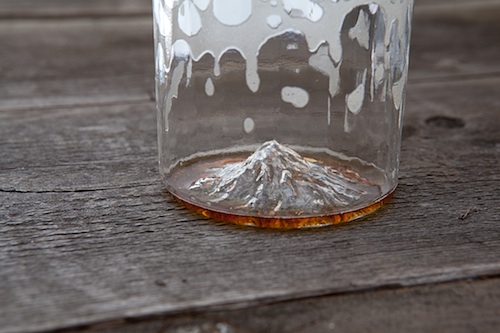3D Printing Helps Quench Thirst for Entrepreneurship

North Drinkware saved $20,000 by prototyping its Oregon Pint with MakerBot. Image Courtesy of North Drinkware, Dustin Ortiz and Stone Crandall
Latest News
August 28, 2015
What do a group of Oregon friends do when they're sitting around drinking beers? Come up with a design for a custom-made pint glass with a replica of Mount Hood in the base along with a plan for using 3D printing to turn the idea into a marketable product.
The trio of friends, Nic Ramirez, Matt Capozzi, and Leigh Capozzi started North Drinkware with the idea of making a product connected to the local beer scene in Oregon and the mountains they love. The founders floated their idea for a product on Kickstarter looking for a $15,000 investment to get started and after seven weeks, they had raised almost $500,000, nearly 3,500% over their targeted seed money.
Ramirez, with a mechanical engineering background, and the Capozzi couple, who have more of a marketing/design orientation, turned their pint glass idea into a reality with the help of 3D software and a Makerbot 3D printer. The team leveraged 3D data of Mount Hood from the United States Geological Survey (USGS) to begin making 3D models of the pint glass they envisioned, using a Makerbot printer to output prints used to evaluate the optimal shape, size and how it would feel when held in a hand.
 North Drinkware saved $20,000 by prototyping its Oregon Pint with MakerBot. Image Courtesy of North Drinkware, Dustin Ortiz and Stone Crandall
North Drinkware saved $20,000 by prototyping its Oregon Pint with MakerBot. Image Courtesy of North Drinkware, Dustin Ortiz and Stone CrandallSeveral CAD packages were integral to the process, including Rhino, Pro/Engineer and KeyShot, along with a few custom scripts. Rhino enabled the team to do fast and loose modeling so they could get to a design concept quickly, said Leigh Capozzi. Pro/E's parametric orientation was critical when the team needed to be more iterative about fine details like the curvature continuous radii on the corners or the contours of the mold that help reduce cracking in the lips of the glasses during the hot popping process, she explained.
From there, the Makerbot 3D printer was tapped to create the initial molds instrumental for producing the proof-of-concept glasses and for helping the team quickly zero in on the design that would work best. “These molds were only good for a few rough glass prototypes, but worked well as proof-of-concept prototypes and gave us the confidence to move into more expensive machined graphite molds,” Capozzi said. The team estimates they saved about $20,000 by minimizing the number of graphite molds required.
Beyond design validation, the Makerbot also evolved to be a critical part of the manufacturing process. 3D printed fixtures helped align the glass during the cold working process, allowing the team to rapidly iterate designs based on insights gained through the production of hundreds of glasses and saving weeks of time and thousands of dollars as opposed to having to machine fixtures.
“One of the things we love about the Oregon pint is that it brings together two complex worlds — the world of 3D data and 3D printing and the age-old craft of blowing glass,” explained Matt Capozzi, one of the co-founders.
Despite his background in engineering and design, Ramirez said current generation Makerbots and 3D modeling software make the process easy, empowering the everyday individual to become an entrepreneur. “It's easy to learn how to build with the 3D modeling software and pretty quickly make that real,” he said. “It's as easy as it's ever been for people to come up with new ideas and then end up holding that idea in their hand.”
Subscribe to our FREE magazine, FREE email newsletters or both!
Latest News
About the Author
Beth Stackpole is a contributing editor to Digital Engineering. Send e-mail about this article to [email protected].
Follow DE





